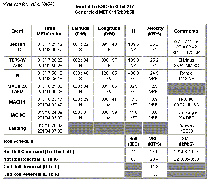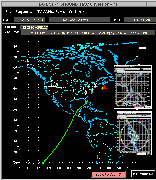Each Shuttle's reentry makes the object of an "Automated DOL PAD". A "DOL PAD" is a Deorbit and Landing Preliminary Advisory Data, which is showing the various data pertaining to the Shuttle's reentry, according to what orbit is chosen for the deorbit burn. The entry-landing process which is decribed on the main page is found back on such a DOL PAD. Technically, once the deorbit burn performed, the Space Shuttle's entry-landing process is divided into three phases, Namely the "Entry", which precedes by 5 minutes the encounter with the atmosphere and which extends down to the "Terminal Area Energy Management (TAEM)". The TAEM is the phase when the Shuttle is slowing down from Mach 2.5 and descending to be aligned with the landing runway, at an altitude of 10,000 ft. The last phase is the "Approach and Landing phase", which is extending from 10,000 ft to touchdown on the runway. see an example of a DOL PAD (MET on the DOL PAD is for "Mission Elapsed Time", that is the time elapsed since the mission's inception)
 | click to a view of a NASA's DOL PAD (this one of those scheduled for the Return to Flight Mission). data and formating NASA |
->More Details
(in chronological order)
| . the Time of Ignition (TIG) is when the orbiter is firing its orbital maneuvering system engines, that is when it's performing the deorbit burn. The change in velocity the burn is causing is termed "delta V" (DV). Delta time (DT) is the duration of the burn |
| . a NASA Tracking and Data Relay Satellites (TDRS) has its signal acquired by the Shuttle at a certain moment before the orbiter encounters the Earth's atmosphere |
| . the angle of attack -the angle of the Shuttle's nose toward the oncoming air pressure- is very high, in the order of 40° |
| . the moment when the Shuttle reaches the Earth's atmosphere is called the "Entry Interface" (EI). This usually occurs at an altitude of 400,000 ft (124 km) |
| . the "Roll Schedule" is the term ascribed to when the orbiter performs a series of four steep turns in the order of slowing down. This occurs and an altitude where the air begins to build up as heating is subsiding somewhat. During such maneuvers the Shuttle's nose keeps to be at a 40-degree angle. It's then only that the nose is slowly brought down, as the Shuttle descends and slows |
| . Terminal Area Energy Management (TAEM) begins with the moment when the Shuttle has slowed down to a speed of 2.5 times the speed of sound. During the TAEM, the Shuttle is going to pass from an altitude of about 83,000 ft and a speed of Mach 2.5 to an altitude of 10,000 ft, with Shuttle aligned with the landing runway |
| . when the Shuttle reached Mach 1 (that is the speed of sound, 740 mph), the Shuttle's commander takes the manual control of the spacecraft for approach and landing |
| . to get aligned with the landing runway, the Shuttle is using the Microwave Scan Beam Landing System (MSBLS) which is installed at the Shuttle landing site. This device is guiding the Shuttle during its final approach to the runway. The MSBLS is generating a "Heading Alignement Cylinder" (HAC), that is a radio cylinder of sort. The radio beacon is intercepted by the orbiter. The orbiter then is performing a turn to align to the runway, as it's rapidly descending at the same time. The Shuttle can turn as much as almost a full circle (360°). The actual amount of turn is usually between 200 and 300 degrees |
| . the landing is the end of the Shuttle's entry-landing process |
 | click to a view of the Shuttle's groundtracks during the entry-landing process. pictures NASA |
Chaque rentrée de la navette spatiale fait l'objet d'un "Automated DOL PAD". Un "DOL PAD" est un "Deorbit and Landing Preliminary Advisory Data" (un "bulletin d'avis donnant les données préliminaires pour un départ de l'orbite et un atterrissage"). Le bulletin montre les différentes données pertinentes à une rentrée de la navette dans l'atmosphère, fonction de l'orbite qui est choisie pour exécuter la mise à feu aux fins de quitter l'orbite. Le processus d'entrée dans l'atmosphère et d'atterrissage que nous avons décrit sur la page principale se retrouve sur le DOL PAD. Une fois la mise à feu exécutée, le processus de rentrée-atterrissage, techniquement, se divise en trois phases: l'"entrée" ("Entry"), qui précède la rencontre avec l'atmosphère de 5 minutes et qui court jusqu'à la TAEM ("Terminal Area Energy Management", "gestion de l'énergie dans la zone terminale"). La TAEM est la phase au cours de laquelle la navette ralentit en-dessous de Mach 2,5 et descend pour s'aligner avec la piste à une altitude de 10 000 pieds. La dernière phase est la "phase d'approche et d'atterrissage" ("Approach and Landing phase") qui court de 10 000 pieds au poser sur la piste. voir (en anglais seulement) un exemple de DOL PAD ("MET" signifie "Mission Elapsed Time", le temps écoulé depuis le début de la mission)
->Plus de détails
(ordre chronologique)
| . l'heure de mise à feu ("Time of Ignition", TIG) est l'heure à laquelle la navette met à feu ses "moteurs du système de manoeuvre en orbite", c'est-à-dire exécute la mise à feu aux fins de quitter l'orbite. Le changement de vitesse que la mise à feu induit est appelé "delta V" (DV). "Delta time" (DT) est la durée du fonctionnement des moteurs |
| . la navette, à un moment donné, avant de rencontrer l'atmosphère terrestre, acquiert le signal d'un satellite de suivi et de relais de données de la NASA (un "Tracking and Data Relay Satellites", TDRS) |
| . l'angle d'attaque (l'angle du nez de la navette par rapport à la pression de l'air) est très élevé, de l'ordre de 40° |
| . le moment où la navette spatiale atteint l'atmosphère terrestre est appelé l'interface d'entrée ("Entry Interface", EI). Cela a habituellement lieu à une altitude de 400 000 pieds (124 km) |
| . le "Roll Schedule" ("horaire des virages") désigne le moment où la navette exécute une série de 4 virages serrés afin de se ralentir. Cela a lieu à une altitude où la pression de l'air commence à augmenter -et la chaleur à diminuer quelque peu. Pendant ces virages, le nez de la navette conserve un angle d'attaque de 40°! Ce n'est qu'ensuite que le nez est lentement abaissé, une fois que la navette descend et ralentit |
| . la phase TAEM ("Terminal Area Energy Management", "gestion de l'énergie dans la zone terminale") commence au moment où la navette a ralenti à deux fois la vitesse du son. Pendant la TAEM, la navette passe d'une altitude d'approximativement 83 000 pieds et d'une vitesse de Mach 2,5 à une altitude de 10 000 pieds et la navette alignée avec la piste d'atterrissage |
| . lorsque la navette atteint Mach 1 (la vitesse du son), le commandant de la mission prend le contrôle manuel de la navette pour l'approche et l'atterrissage |
| . la navette, pour s'aligner avec la piste, utilise le "Microwave Scan Beam Landing System" (MSBLS), cette aide à l'atterrissage qui est installée au site d'atterrissage. Ce système d'approche aux instruments guide la navette spatiale pendant son approche finale vers la piste. Le MSBLS génère un "cylindre d'alignement de cap" ("Heading Alignement Cylinder", HAC), c'est-à-dire une sorte de cylindre d'ondes radio. Le faisceau est intercepté par la navette et celle-ci exécute un virage pour s'aligner avec la piste. Dans le même temps, elle descend rapidement. Le virage effectué peut presqu'atteindre la valeur d'un cercle complet de 360°. La valeur du virage varie habituellement entre 200 et 300° |
| . l'atterrissage conclut le processus de rentrée et d'atterrissage de la navette spatiale |
Les deux schémas (dans la partie anglaise ci-dessus; en anglais seulement) sont (le premier) un DOL PAD (celui du retour de la première mission de Retour au Vol), et (le second) un diagramme des trajectoires au sol d'une navette lors d'un processus de rentrée-atterrissage. données et formatage NASA pour le DOL PAD, images NASA pour les trajectoires au sol
Website Manager: G. Guichard, site 'Amateur Astronomy,' http://stars5.6te.net. Page Editor: G. Guichard. last edited: 12/28/2010. contact us at ggwebsites@outlook.com